#reptile bone fossil
Explore tagged Tumblr posts
Photo

RARE Fossil Ceratodus Coprolite with Reptile Bones Westbury Formation Triassic Aust Cliff Bristol UK Authentic
This listing features a rare and highly sought-after fossil coprolite (fossil poo) attributed to the prehistoric lungfish genus Ceratodus, preserved within a fossil-rich block containing reptile bone fragments. The specimen was discovered by our expert team (Alister & Alison) on 07 April 2025 at the renowned Aust Cliff, Bristol, from the Westbury Formation, Penarth Group, dating to the Upper Triassic period (~208 million years ago).
The Westbury Formation at Aust Cliff is internationally famous for its fish, reptile and coprolite bed, a layer of sediment rich in vertebrate remains deposited in a lagoonal to marginal marine environment during the final stages of the Triassic. This locality marks the transition between the Triassic and Jurassic periods and has yielded numerous important fossils.
About Ceratodus & This Coprolite:
Genus: Ceratodus (prehistoric lungfish)
Fossil Type: Coprolite with visible inclusions of bone and possible scale fragments
Morphology: Elongated cylindrical coprolite with surface impressions, fine preservation of inclusions
Preservation: The coprolite is mineralised, likely composed of calcium phosphate, showing embedded reptilian bone debris, which may have been ingested
Reptile Bone Inclusions:
Small fossil bone fragments embedded within or alongside the coprolite
May originate from small reptiles or amphibians inhabiting the same depositional environment
Geological & Scientific Details:
Species Attribution: Ceratodus sp. (coprolite producer)
Geological Formation: Westbury Formation
Group: Penarth Group
Depositional Environment: Marginal marine to lagoonal (low oxygen, promoting fossil preservation)
Geological Age: Upper Triassic (Rhaetian Stage)
Biozone: Rhaetian Vertebrate Bed (informal, Aust Cliff local faunal assemblage)
Location: Aust Cliff, Bristol, United Kingdom
This fossil not only showcases a fascinating example of prehistoric digestive processes but also preserves part of the food web from the Triassic ecosystem. Specimens with multiple fossil elements from this famous bed are rarely available.
The photo shows the actual specimen you will receive. Scale cube = 1cm. For full sizing, please see the image.
All of our Fossils are 100% Genuine Specimens & come with a Certificate of Authenticity.
Carefully selected, professionally cleaned and prepped by Alison, this is an exceptional collector's item from a site of international palaeontological significance.
#Ceratodus coprolite#fossil fish poo#reptile bone fossil#Aust Cliff fossil#Westbury Formation#Penarth Group#Upper Triassic fossils#coprolite with bone fragments#UK vertebrate fossil#fish coprolite#fossil faeces#Triassic coprolite#Ceratodus tooth#lungfish coprolite#ancient reptile bone#fossil bone block#Bristol fossil site
0 notes
Text
Presently going insane rn:

Anyway let me talk about the one question that I have been contemplating ever since I began rotating petrosapiens in my mind. How the fuck do babies?
If you caught the reblog before this post, you might have noticed that a post about fat in aliens brought me to think about petrosapien fat, which contradicts a lot of what I've already established for them being an exoskeletal species, let alone being a hard sell in the sci-fantasy of rock crystal people of canon. Turning to one of my two animal inspirations of petrosapiens - bugs and more specifically in this case insects - I found out that insects can't build up fat, not in the way mammals or reptiles can, BUT they store the most of it in a very significant stage;
Larvae!
Then it fucking hit me, I already made some early headcanons about child development in petrosapiens (though I can't remember if I posted them or had a post ready to send) where they were already in a metamorphosing stage, though the responsibility fell solely to the layer who would use crystallokinesis to feed an 'egg'. I didn't fully like the idea though mostly in retrospect, because it felt strange in the 'pulled out of my ass' kinda way, a method of child rearing that felt more obligated to use crystallokinesis as a primary source for feeding to sorta justify at the time the inherent power petrosapiens have towards crystallokinesis.
Instead, between then and now I fully connected the idea that crystallokinesis is less of a power and more of an extension of a petrosapien's nervous system, compression of quartz through the use of a more electrical based nerve network that happens to not distinguish between person crystals and the similar crystalline structures of Petropia. With this in mind and the new idea that petrosapiens have larvae, wouldn't it be so cool if the larvae had the typical Earth-like electrochemical nervous system of humans (or I suppose bugs here) that adapts to an electrical focused nervous system through the process of metamorphosis? Where the larvae creates it's petrosapien crystal skin by building a chrysalis and melting within it to create their new body?
Unlike my old headcanon where the layer had to remain with the egg and constantly feeding them with crystallokinesis, this larvae version can feed itself when provided and so long as the chrysalis is well protected, the moment metamorphosis stage takes place the parent(s) can have momentary reprieve from child rearing and better prepare themselves for the toddler/adolescent stage for their child. The little grub probably doesn't even eat crystals in the early stages of their larvaehood since eating crystals initially marks as the materials for chrysalis building before it becomes a nutritional food source. Instead the little grub might be feed plants and potentially animal products in order for it to inherit and develop the chemicals required to build a crystallovorous stomach and the acids used to break silica down into digestible nutrition.
That does mean that early child rearing is a little bit more functionally deadly towards the very crystalline parents, who have to legitimately watch so that their fingers aren't bitten off, but holding the little grub is easy when it's covered in silicone membrane. The larvae at this stage is a little bit more resistant to any crystallovorous plant secretions due to the polymers of it's membrane, as well as the higher diversity of oxygen, hydrogen, and carbon in it's body it has in comparison to adults or adolescents who've undergone metamorphosis, their innards becoming a more uniform silicone and their skin being the crystalline silicon many crystallovorous stomachs have adapted to eat.
It also means that the shape of a grub is also considered to be cute to a petrosapien. Things from caterpillars to maggots look so much more charming to a petrosapien's eyes that back on Petropia there would be a large proportion of pet owners having what would considered on Earth to have bugs for pets. In fact, a rather common form of pet Petrosapiens might have would be a large millipede/centipede like animal that would be the size approximate of a feather boa and often held that way too, because while they do not undergo metamorphosis, they look like a larval grub well into adulthood and are considered to be very cute for it. Pet owners with these pets who are also parents love to see their little larvae and their 'dog' getting along and would love telling their adolescent all the cute stories of the little grubs curled up against each other. Petrosapiens in the age of the Surface Craze might have had the opportunity to get a few baby pictures like that, and it would be considered very cute unless you were a human afraid of bugs or not personally a fan.
Petrosapiens on Earth might see the miniature bugs and explode with cuteness overload, others might fuck around and find out that they can make human-petrosapien hybrids Makarat you chupacabra you're lucky petrosapien kids aren't born with crystals pay child support to your human wife who birthed a grub-!
And that's the post send tweet-
#petrosapien#ben 10#xenobiology#at this point i only think about petrosapiens as bugs rarely as reptiles- maybe i should add more reptile stuff#like leathery eggs that the grubs eat their way out of yeah let's add that#since the larvae don't have powerful enough stomachs to eat crystals yet let alone the jaw strength#which looking at a grub you can see the vague body plan of a petrosapien#the opening face- the significantly more developed rear legs (present as 'swimmerets')-#you can (mostly) tell from even the grub stage that your kid's a guy or a girl because they even have the nubs for back spines in grub stag#even if it turns out to be an excess/lack of 'testosterone' or an intersex trait#it was their grubs that petrosapiens were even able to connect themselves to old fossil records-#an extinct shrimp or prawn type thing that shares similarities to their little grub- though already with armour or even exoskeleton#also this grub thing makes the crystal twins slightly less of a hassle at least for the still unnamed human mother because i suck at names#means lucía had a grub for a twin sister for a hot while- nor did the family have much in the way for crystal for blanca to eat#so instead of crystals blanca ate bones for her chrysalis and hey look she's bone white now which- oopsie osteokinesis#no matter all the crystallokinesis that happens is with lucía and oof ouchie it's scoliosis#well- replacing keratin AND scoliosis but woopsie#that should be in an oc post
20 notes
·
View notes
Text

If you’ve visited the Museum, you’re certainly familiar with today’s Fossil Friday feature: the Barosaurus and Allosaurus in the Rotunda! Rising 50 ft (15 m) above the ground, it’s the world’s tallest freestanding dinosaur mount. In this scene, a Barosaurus rears up to defend her young from an Allosaurus. How does the huge skeleton of Barosaurus—whose name means “heavy reptile”—stay up? The Barosaurus is built from casts of real fossil bones, while the originals are housed in the Museum’s collections. Real fossil bones would be too heavy to support this way.
Spot these dinosaurs and more at the Museum! Plan your visit.
Photo: D. Finnin / © AMNH
822 notes
·
View notes
Text
nerds make the best date ; tsukishima kei



oneshot & fluff ↪ in which y/n finally agrees to go out with tsukishima— only to discover his idea of a “date” involves fossils, sarcasm, and maybe, somehow, so accidental kiss. ↷ tsukishima kei ; haikyuu
↳ an order of flat white from anonymous in the comeback cafe event !

IT WAS NOT what she expected.
When Kei Tsukishima finally—finally asked her out after weeks of dry sarcasm and prolonged glances over lunch boxes, Y/n thought it might be something normal. Coffee. A movie. Maybe walking around town, sharing earbuds or something cheesy like that.
What she didn’t expect was a quiet, dusty museum with minimal lighting, a single vending machine, and a paleontological exhibit about prehistoric marine reptiles.
She stood in front of a giant fossil of a mosasaur, blinking slowly. Tsukishima stood next to her, arms crossed, an almost imperceptible smirk on his lips.
"You brought me to a museum."
"Wow, look at you. You can identify your surroundings."
She shot him a look. He didn’t flinch.
"Most people do dinner or movies, Tsukki."
"Most people are boring. Besides, you said you liked dinosaurs."
Her cheeks heated. That was true. She had said that — in passing, once, during study hall, and he’d barely looked up from his notes.
Apparently, he did listen.
She stared at the fossil again, this time with a flutter she didn’t expect in her chest.
Still.
"You call this a date?" she muttered under her breath.
Tsukishima shrugged, stuffing his hands in his jacket pockets. "I didn’t say it was. You’re the one who assumed."
"So it’s not?"
"Do you want it to be?"
She turned to him. His golden eyes met hers, unreadable — except for the smallest flicker of nerves behind the glasses. He wasn’t good at this. That much was obvious. He hadn’t even said the word “date” when he invited her. Just a grumbled, “You’re free Saturday, right?”
"I didn’t wear my cute socks for a non-date," she said finally.
He blinked. "That’s… a weird thing to say."
"You’re a weird thing to say."
A pause. He snorted.
The rest of the museum passed quietly, with her pointing out cool bones and him subtly spouting facts like he wasn’t a nerd. She only caught him staring once, in the reflection of the glass over a velociraptor skeleton. He looked away quickly, ears red.
Later, they sat on a bench outside, cold drinks in hand, the late afternoon sun dipping behind the city buildings. The silence was comfortable, almost warm.
She kicked her foot out, tapping his sneaker with hers.
"Still not calling it a date?"
He exhaled through his nose. "You really need a label for everything, huh?"
"You kissed me after the exhibit."
"You kissed me."
"So it was a date."
He looked at her sideways. Then back to his drink. His fingers brushed against hers on the bench between them.
"Yeah. I guess it was."
Her heart did a little somersault.
"Then next time," she said, nudging his shoulder, "We’re getting ice cream. Or boba. Something with sugar and neon lights."
"So you’re already planning a next time?"
"Are you saying there won’t be?"
Another glance. His lips twitched— the closest thing Tsukishima had to a grin.
"Fine. But only if you don’t wear those socks again. They have tiny T-Rexes in lab coats. I can't take you seriously."
"Rude. You loved those socks."
"Shut up."
And maybe she still didn’t get her rom-com date with fireworks and confession speeches— but she did get Kei Tsukishima. Sarcasm, fossils, nerdiness, and all.
She could live with that.

© eriace ;; don’t repost my works.
#haikyuu#haikyuu oneshot#haikyuu x reader#haikyuu!!#hq#haikyuu kei#haikyuu tsukishima#tsukishima kei#tsukishima x reader#tsukishima fluff#tsukishima kei x reader#kei tsukishima#kei tsukishima x reader
558 notes
·
View notes
Text
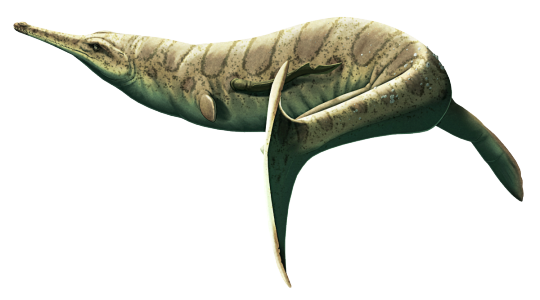
Metriorhynchids were a group of fully marine crocodyliforms known from the mid-Jurassic to the early Cretaceous of Europe and the Americas. They were the most aquatic-adapted of all known archosaurs, with streamlined bodies, smooth scaleless skin, small front flippers, larger hind flippers, and shark-like tail flukes. They may also have been endothermic, and might even have given live birth at sea rather than laying eggs.
Rhacheosaurus gracilis here was a metriorhynchid that lived in warm shallow waters around what is now Germany during the late Jurassic, about 150 million years ago. Around 1.5m long (~5'), its long narrow snout lined with delicate pointed teeth suggests it fed on small soft-bodied prey, a niche partitioning specialization that allowed it to coexist with several other metriorhynchid species in the same habitat.
Unlike most other marine reptiles metriorhynchids didn't have particularly retracted nostrils, which may have had a limiting effect on their efficiency as sustained swimmers since higher-set nostrils make it much easier to breathe without having to lift the whole head above the surface. The lack of such an adaptation in this group may be due to their ancestors having a single nasal opening formed entirely within the premaxilla bones at the tip of the snout, uniquely limiting how far it could easily shift backwards – other marine reptiles had nostrils bound by the edges of multiple different bones, giving them much more flexibility to move the openings around.
(By the early Cretaceous a close relative of Rhacheosaurus did actually evolve nostrils bound by both the premaxilla and the maxilla, and appeared to have started more significant retraction, but unfortunately this only happened shortly before the group's extinction.)
Metriorhynchids also had well-developed salt glands in front of their eyes, but the large sinuses that accommodated these glands may have made their skulls ill-suited to deep diving, being more susceptible to serious damage from pressure changes and restricting their swimming to near-surface waters only.
Preserved skin impressions in some metriorhynchid fossils show several unusual "irregularities", including curl shapes, small bumps, and cratering. It's unknown what exactly caused these marks, but they may represent scarring from external parasites such as lampreys and barnacles.
———
NixIllustration.com | Tumblr | Patreon
References:
Andrade, Marco BD, and Mark T. Young. "High diversity of thalattosuchian crocodylians and the niche partition in the Solnhofen Sea." 56th Symposium of Vertebrate Palaeontology and Comparative Anatomy, 2008. https://svpca.org/years/2008_dublin/abstracts.pdf#page=14
Séon, Nicolas, et al. "Thermophysiologies of Jurassic marine crocodylomorphs inferred from the oxygen isotope composition of their tooth apatite." Philosophical Transactions of the Royal Society B 375.1793 (2020): 20190139. https://doi.org/10.1098/rstb.2019.0139
Spindler, Frederik. "Live Birth in a Jurassic Marine Crocodile." Abstracts of the 90th Annual Meeting of the Paläontologische Gesellschaft, 2019. https://www.palaeontologie.geowissenschaften.uni-muenchen.de/pdfs/palges2019_abstracts.pdf#page=141
Spindler, Frederik, et al. "The integument of pelagic crocodylomorphs (Thalattosuchia: Metriorhynchidae)" Palaeontologia Electronica 24.2 (2021): a25. https://doi.org/10.26879/1099
Young, Mark T., et al. "Convergent evolution and possible constraint in the posterodorsal retraction of the external nares in pelagic crocodylomorphs." Zoological Journal of the Linnean Society 189.2 (2020): 494-520. https://doi.org/10.1093/zoolinnean/zlaa021
Young, Mark T., et al. "Skull sinuses precluded extinct crocodile relatives from cetacean-style deep diving as they transitioned from land to sea." Royal Society Open Science 11.10 (2024): 241272. https://doi.org/10.1098/rsos.241272
Wikipedia contributors. “Metriorhynchidae” Wikipedia, 12 Nov. 2024, https://en.wikipedia.org/wiki/Metriorhynchidae
Wikipedia contributors. “Rhacheosaurus” Wikipedia, 02 Dec. 2024, https://en.wikipedia.org/wiki/Rhacheosaurus
#science illustration#paleontology#paleoart#palaeoblr#rhacheosaurus#metriorhynchidae#thalattosuchia#crocodyliformes#crocodylomorpha#pseudosuchia#archosaur#art#marine reptile#lamprey#barnacle#parasite
547 notes
·
View notes
Text
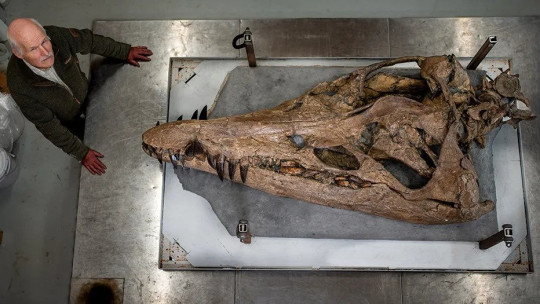
Gigantic Skull of Prehistoric Sea Monster Found on England’s ‘Jurassic Coast’
The remarkably well-preserved skull of a gigantic pliosaur, a prehistoric sea monster, has been discovered on a beach in the county of Dorset in southern England, and it could reveal secrets about these awe-inspiring creatures.
Pliosaurs dominated the oceans at a time when dinosaurs roamed the land. The unearthed fossil is about 150 million years old, almost 3 million years younger than any other pliosaur find. Researchers are analyzing the specimen to determine whether it could even be a species new to science.
Originally spotted in spring 2022, the fossil, along with its complicated excavation and ongoing scientific investigation, are now detailed in the upcoming BBC documentary “Attenborough and the Jurassic Sea Monster,” presented by legendary naturalist Sir David Attenborough, that will air February 14 on PBS.

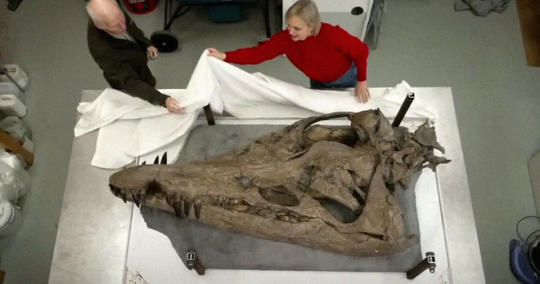
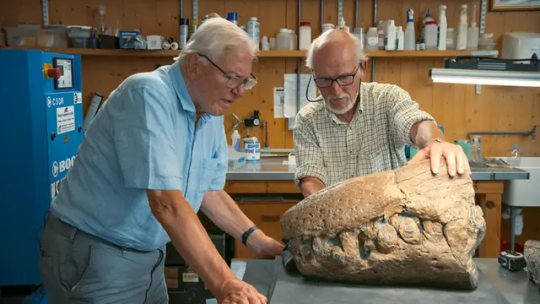
Such was the enormous size of the carnivorous marine reptile that the skull, excavated from a cliff along Dorset’s “Jurassic Coast,” is almost 2 meters (6.6 feet) long. In its fossilized form, the specimen weighs over half a metric ton. Pliosaurs species could grow to 15 meters (50 feet) in length, according to Encyclopaedia Britannica.
The fossil was buried deep in the cliff, about 11 meters (36 feet) above the ground and 15 meters (49 feet) down the cliff, local paleontologist Steve Etches, who helped uncover it, said in a video call.
Extracting it proved a perilous task, one fraught with danger as a crew raced against the clock during a window of good weather before summer storms closed in and the cliff eroded, possibly taking the rare and significant fossil with it.
Etches first learned of the fossil’s existence when his friend Philip Jacobs called him after coming across the pliosaur’s snout on the beach. Right from the start, they were “quite excited, because its jaws closed together which indicates (the fossil) is complete,” Etches said.
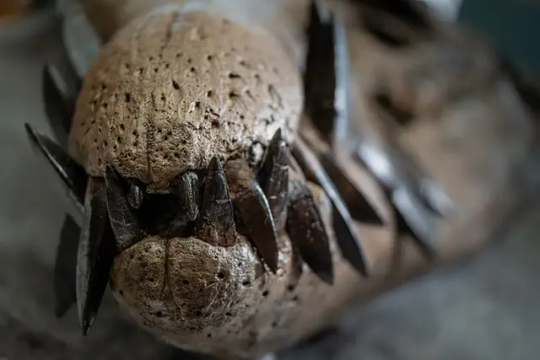
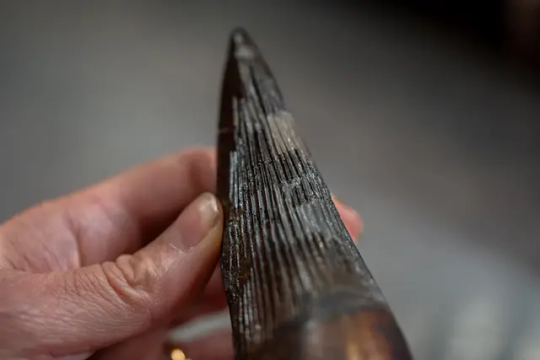
After using drones to map the cliff and identify the rest of the pliosaur’s precise position, Etches and his team embarked on a three-week operation, chiseling into the cliff while suspended in midair.
“It’s a miracle we got it out,” he said, “because we had one last day to get this thing out, which we did at 9:30 p.m.”
Etches took on the task of painstakingly restoring the skull. There was a time he found “very disillusioning” as the mud, and bone, had cracked, but “over the following days and weeks, it was a case of …, like a jigsaw, putting it all back. It took a long time but every bit of bone we got back in.”
It’s a “freak of nature” that this fossil remains in such good condition, Etches added. “It died in the right environment, there was a lot of sedimentation … so when it died and went down to the seafloor, it got buried quite quickly.”
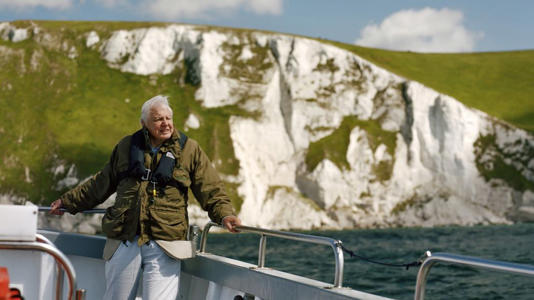
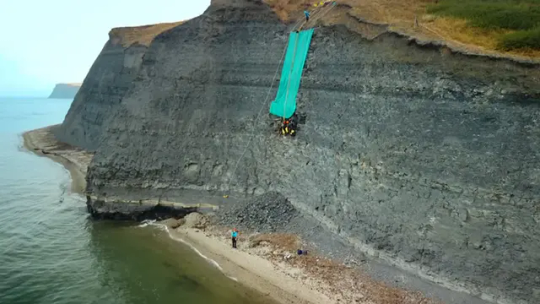
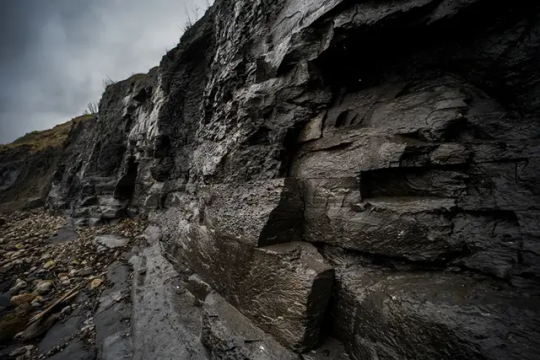
Fearsome top predator of the seas
The nearly intact fossil illuminates the characteristics that made the pliosaur a truly fearsome predator, hunting prey such as the dolphinlike ichthyosaur. The apex predator with huge razor-sharp teeth used a variety of senses, including sensory pits still visible on its skull that may have allowed it to detect changes in water pressure, according to the documentary.
The pliosaur had a bite twice as powerful as a saltwater crocodile, which has the world’s most powerful jaws today, according to Emily Rayfield, a professor of paleobiology at the University of Bristol in the United Kingdom who appeared in the documentary. The prehistoric marine predator would have been able to cut into a car, she said.
Andre Rowe, a postdoctoral research associate of paleobiology at the University of Bristol, added that “the animal would have been so massive that I think it would have been able to prey effectively on anything that was unfortunate enough to be in its space.”
By Issy Ronald.
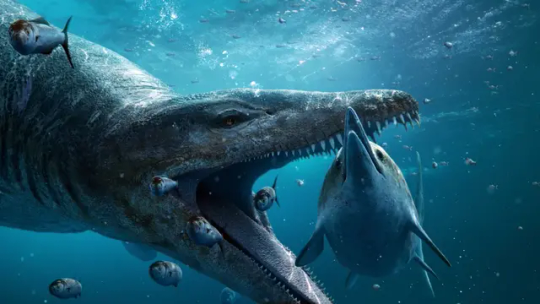
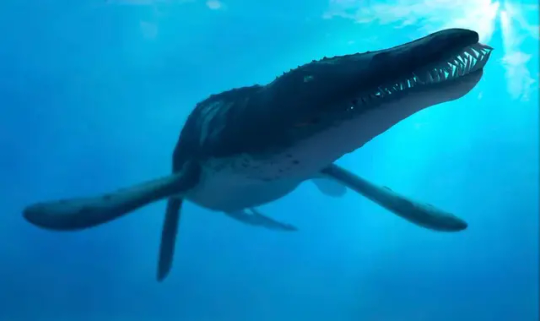
#Gigantic Skull of Prehistoric Sea Monster Found on England’s ‘Jurassic Coast’#Dorset England#pliosaur#jurassic#fossil#prehistoric#dinosaur#paleobiology#palaeontologists#archaeology#archeolgst#history#history news#ancient history#Sir David Attenborough#nature#naturalist
2K notes
·
View notes
Photo

Polished Fossil Slab – Fish, Shark, Reptile Bone & Coprolite, Aust Cliff UK, Triassic Period
Presenting a rare and scientifically significant Polished Slab of Fossil Fish, Shark Bone, Reptile Bone, and Coprolite from the Westbury Formation, part of the Penarth Group, dated to the Upper Triassic (Rhaetian) approximately 208–201 million years ago. This exceptional piece was sourced from Aust Cliff, near Bristol, United Kingdom, a world-famous Triassic fossil locality.
The slab contains a unique fossil assemblage including:
Fragmented fish bones and scales
Shark and marine reptile bone fragments
Abundant coprolites (fossilised faeces), often spiral or rounded in morphology
All fossil components are preserved within a dark, fine-grained sedimentary matrix and have been expertly polished on one surface to reveal the textures, inclusions, and contrast of this fossil bed.
Fossil Type: Multi-species fossil bed including vertebrate remains and trace fossils (coprolites)
Geological Age: Upper Triassic – Rhaetian Stage
Formation: Westbury Formation
Group: Penarth Group
Depositional Environment: Formed in a coastal lagoonal or shallow marine setting with fluctuating salinity and periodic anoxic events. The Westbury Formation is known for bone beds where marine vertebrates and organic debris accumulated and were rapidly buried in low-oxygen sediments, aiding exceptional preservation.
Morphological Features:
Irregular fragments of fish and reptile bone, embedded in matrix
Rounded and spiral coprolites of varying sizes
Polished surface highlights bone textures and organic inclusions
Notable:
Authentic slab from Aust Cliff, one of the most famous Upper Triassic sites in the UK
Displays diverse fossil content in a single polished surface
Excellent for collectors, museums, academic study, or decorative purposes
The actual specimen shown in the listing photograph
Authenticity: All of our fossils are 100% genuine natural specimens and come with a Certificate of Authenticity. The item photographed is the exact specimen you will receive. Each cube or square in the scale represents 1cm – please refer to the image for full sizing.
This Polished Fossil Slab from Aust Cliff offers a fascinating snapshot of life in the waning years of the Triassic period, preserved within the storied sediments of the Westbury Formation. A rare and beautiful piece for any serious collector or enthusiast.
#Aust Cliff Fossil#Westbury Formation#Coprolite Fossil#Reptile Bone Fossil#Fossil Fish Slab#Triassic Fossil UK#Fossil Shark Bone#Upper Triassic Fossils#Bristol Fossil Bed#Fossil Reptile Slab#Fossil Collector Specimen#Genuine Fossil Slab#UK Fossil#Penarth Group Fossil
0 notes
Text
Today Marks 200 Years of Dinosaurs!!
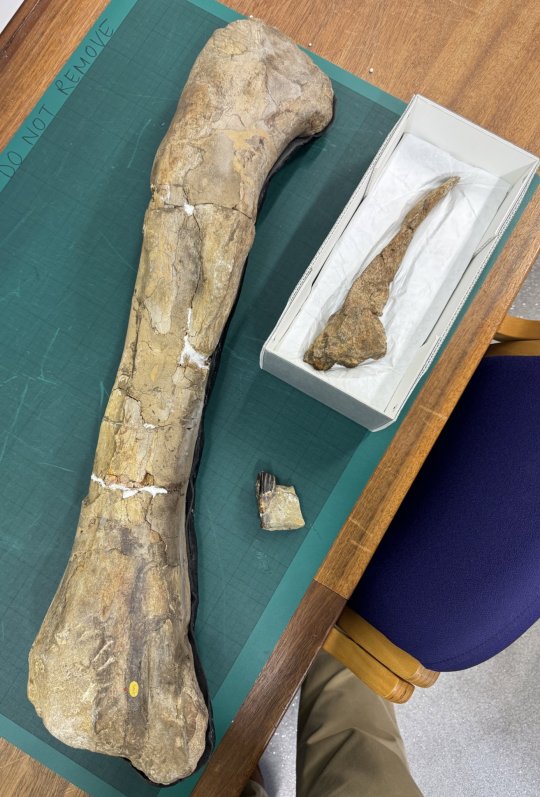
Photo by Paul Barrett (image link here).
On this day, February 20th, 1824, bones from the Stonesfield Slate in Oxfordshire, England were described by William Buckland. Dinosaur fossils have likely been known since time immemorial, but that day was the first time a dinosaur had been described by western science (being the predatory Megalosaurus). Two decades later, Richard Owen would use the three fossils shown above - belonging to three separate animals Megalosaurus (leg), Iguanodon (tooth), and Hylaeosaurus (spine) - to formally recognize Dinosauria as a lineage of animals. Today over a thousand Mesozoic dinosaur genera are known, with many being described on a monthly basis, and our understanding of these animals has grown tremendously since the 1820s. We now recognize that dinosaurs were sophisticated, highly active reptiles with diverse behaviors of which one lineage survived the great Cretaceous Mass Extinction Event: the birds. Paleontologist Darren Naish has said that dinosaurs are popular "because they look neat, because they're awesome in every sense of the word, because they ruled a vast, chaotic, complex wilderness, and because they're the source of a myriad of big, really interesting questions". And I'm sure we all couldn't agree more.
So here's to 200 Years of Dinosaurs! How will you celebrate one of the world's most popular and incredible animals?
1K notes
·
View notes
Text

Species of Ichthyosaur Is Largest Known Marine Reptile at 80 Feet Long
A father and daughter duo found the jawbone of the species and the research team named the new marine reptile species Latin for 'giant fish lizard of the Severn.'
A father and daughter, searching for fossils on an English beach, found more than they expected: the jawbone of what may be the largest known marine reptile. Scientists estimate that the giant ichthyosaur, from which the jawbone came, measured 80 feet long and lived during the late Triassic period. A report in the journal PLOS details the find. When Justin Reynolds and Ruby Reynolds (then 11) were combing the beach at Somerset in 2020 and came upon a giant bone chunk, they knew they were on to something. “When Ruby and I found the first two pieces we were very excited as we realized that this was something important and unusual,” said Reynolds in a release. So they contacted Dean Lomax, a University of Manchester paleontologist...
Read more: https://www.discovermagazine.com/the-sciences/species-of-ichthyosaur-is-largest-known-marine-reptile-at-80-feet-long
204 notes
·
View notes
Text
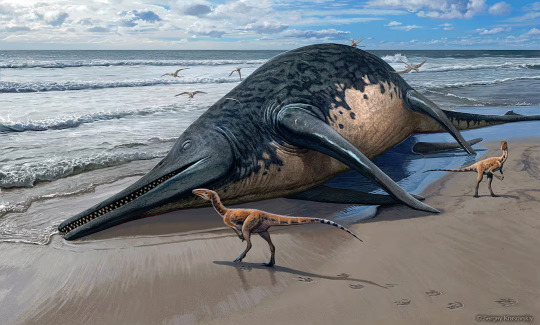
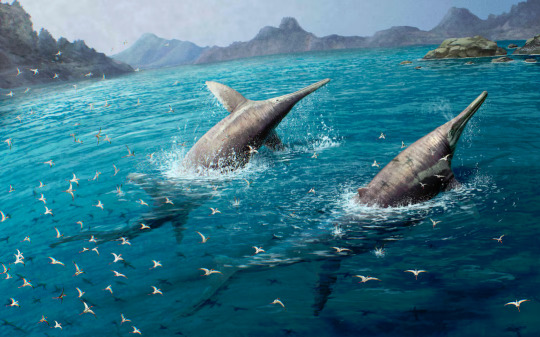
Gigantic marine reptile's fossils found by British girl and father April 17 (Reuters) - A fossil jawbone found by a British girl and her father on a beach in Somerset, England belongs to a gigantic marine reptile dating to 202 million years ago that appears to have been among the largest animals ever on Earth. Researchers said on Wednesday the bone, called a surangular, was from a type of ocean-going reptile called an ichthyosaur. Based on its dimensions compared to the same bone in closely related ichthyosaurs, the researchers estimated that the Triassic Period creature, which they named Ichthyotitan severnensis, was between 72 and 85 feet (22-26 meters) long. That would make it perhaps the largest-known marine reptile and would rival some of the largest baleen whales alive today. The blue whale, considered the largest animal ever on the planet, can reach about 100 feet (30 meters) long.
Don't mind me, just thinking about how fossils for marine life are rarer than for land-based life and there could have been all kinds of shit living in there that we haven't even discovered yet.
592 notes
·
View notes
Text
— Dinosaur Museum

Pairing; Ellie Williams x GN!Reader
Summary: You take Ellie to a dinosaur museum, giving her the chance to unload all her nerdy dinosaur facts on you.
a/n: this is also the chance to unload all my nerdy facts on you :3
☆☆☆☆☆☆☆☆☆☆
"Babe, this is gonna be the best day of your life, I promise." Ellie excitedly pulled you through the gate of the dinosaur museum. You giggled as Ellie's eyes lit up at the sight of the dinosaur exhibition. There were large statues of dinosaurs at the entrance, and towards the back, you could see dinosaur bones encased in display cases. Her grip around your hand tightened and she pointed towards one of the statues. "That's a Stegosaurus. They were herbivorous and lived in the late Jurassic period. Their fossils have been found in North America and Portugal. People used to think they had two brains but that was just a myth that started in the 1870s." Ellie explained "Whoever believed that myth had to be stupid. Two brains? What idiots." You laughed and shook your head at your girlfriend's words, "You would've believed it too" She gasped and pulled away from you, "Are you calling me stupid?"
You shrugged, walking towards a large statue of a T-Rex, "Take it as you want." Ellie decided to ignore your comment as she noticed the dinosaur statue you'd walked up to.
"What's this one, Els?" "You don't know what a Tyrannosaurus Rex is?" She raised an eyebrow.
You rolled your eyes, "I'm giving you the chance to be a nerd, nerd."
Ellie let out a soft "Hmph" before starting her ramble.
"Well, that's a Tyrannosaurus which lived in the Cretaceous period. Their name means 'tyrant lizard' because well, you know, they were cruel and are reptiles. Strangely enough, they aren't considered to be in the same family as lizards, so I have no idea why they're called a lizard."
You hummed, "Why do they have tiny ass arms?"
"It's believed they were used to attack prey that were close to them." Ellie shrugged, "They look pretty stupid with those arms, if you ask me."
You laughed. It did look pretty stupid.
Ellie gasped and ran towards another statue. You assumed it was some water dinosaur due to the large flippers.
"These plesiosaurus are so fucking cool!" Ellie was almost jumping up and down with excitement. "They're called a Liopleurodon which lived in the Jurassic period. They were huge. The biggest one found was 17 meters long. They must have been terrifying. I know I would've shitted my pants if I saw one."
"Ellie, you shit your pants while watching scary TikToks. Everything scares you."
"Oh, okay, whatever." She rolled her eyes, "That was one time. Leave me alone."
It was not, in fact, one time, but you let it go. You'll tease her about it another time.
Ellie spent another three hours explaining facts about each statue in the museum. And you had to admit, it was cute seeing your girlfriend this excited over dinosaurs.
After she had finished ramble about the last dinosaur in the museum, she turned to you with an grin on her face.
"Wasn't that so super fun?" She joyfully asked.
You grinned, kissing her forehead. "It was so super fun watching you geek out."
"Now you can take me to a space museum and listen to me geek out there!"
You laughed, "Another day, baby."
Your brain was not built to take hours of information all at once.
Ellie pouted, but you gave her a quick kiss on the lips, turning her pout into a smile.
She was your little nerdy girl.
#melposts#ellie williams x reader#ellie williams fanfic#jamieposts#ellie williams#ellie williams tlou#ellie williams x y/n#ellie tlou#ellie williams x you#ellie the last of us#tlou ellie#ellie x you#ellie x reader#ellie x y/n
520 notes
·
View notes
Text





WHEW I FINALLY GOT THIS DONE
I really wanted to get the lore on the dragons of Evros, because well one, I fucking love dragons, and two, the latest iteration of my dragon lore is very outdated.
Anyway! Lore stuff under the cut because it’s very long…
Anatomy
The dragons of Evros are not like the common depiction seen in modern tales, with four legs and additional wings. They’re more serpentine in shape with only two limbs. And they also lack the firebreathing of most modern dragons, too…
1: The dragon clade is defined by the atter sac found near their stomach. As it’s a soft organ, this makes figuring out the fossil history of dragons a painful headache. This organ is actually a modified gall bladder, and while it still aids in digestion, the fluid it produces has another use. When the dragon is threatened, it expels the fluid from its gall, and breathes it out as a corrosive gas that melts flesh. Oddly enough, the corrosion doesn’t affect plant matter much, but it does affect metal.
2: Dragons have a pair of fins at their head for display, communication, and processing sound. Their horns are in pairs of four, while usually short some dragons prefer to grow them longer.
3: A real trait of many reptile species is the parietal eye, a sort of simplistic third eye at the top of their head. In dragons, this eye is much more complicated, and able to see in the same way as their other two eyes.
4: At the end of a dragon’s body of their tail spade. Tbh I put this here to fill space
5: Like birds and bats, dragons have evolved flight with arms modified into wings. These wings are different from other vertebrate wings however, in that the arm itself is not changed from a regular leg, instead their wings are formed from a fishlike fin attached to the arms. The fins are surprisingly strong and resistant to damage, but by themselves they would just be able to glide. Owing to the magical nature of dragons, they can actually fly. They’re also helpful for swimming, and the claws are good at digging, making dragons true jacks of all trades. (fin wings are based off of Tyrantisterror’s dragons, Midgaheim influenced a lot when it comes to dragons tbh)
Life Cycle
1: As typical of squamates, dragon eggs are soft-shelled. Their delicate nature means they must be guarded at all times, usually by tag team. To break out of their eggs, the hatchlings have an egg tooth (though sometimes they poke their tail spade out first) which they never shed.
2: Baby dragons are hardly recognizable as such, looking more like odd looking snakes. They stay with their parents at all times when very young, but soon will gain the independence to be on their own.
3: Dragonets eventually grow a pair of front legs, though at first they’re small spikes. This is the signal for brumation to begin. The dragonet will dig a burrow for itself, then must eat as much as possible to prepare for their long sleep.
4: Growing a limb is a strenuous process, so going into slumber eases it. The dragon’s legs and wings will grow while buried, and once satisfactorily formed, the dragon’s internal clock will ring and wake them, now with wings ready to fly.
Culture
Like many other organisms touched by magic, dragons are sophonts able to think and communicate on complex levels.
1: The wyrms of Evros are split into three separate ecotypes depending on habitat. The sea dragons or leviathans are the largest of them, with the sea allowing more space to grow than the land. The swamp dragons or knuckers are the smallest, so it’s easier for them to sneak through their forests. The river dragons or wyverns are in the middle regarding size, but have the biggest wings and are the best fliers, a helpful trait in their mountain habitats.
2: An odd behavior of dragons is their tendency to collect objects for a hoard. These hoards are less a random assortment of junk and more complex art pieces. Rocks are arranged in one area while bones are arranged in another. Despite common claims, dragons don’t really prefer precious stones over any other group of curiosities, leaving many an avaricious dragonslayer or their quest giver disappointed. Sea dragons don’t have hoards in the typical sense, instead considering the barnacles and algae and other symbiotes growing upon their body as their hoard.
3: Sea dragons are nomads, same as most oceanic creatures (except when raising their children, which live on land until finishing metamorphosis), but their more terrestrial kin have shelters. River dragons live in mountain caves as close to a river as possible, ideally there when they arrive but sometimes they have to dig them out themselves to avoid fights over territory. There aren’t many caves around swamps, however, so swamp dragons have to build their own homes. With dead or dying trees and a bit of mud, these dens are surprisingly sturdy. While river dragons are more territorial, swamp dragon dens often include small groups of dragons that live in the same territory, albeit with their own chambers. (swamp dragon den concept taken from this post)
4: Like many other reptiles, dragons are semi-social. They don’t need social bonding, nor do they shun it. Between the ecotypes, swamp dragons tend to be the most sociable, as mentioned living in communal dens, while river dragons are the least, only allowing family, old friends, mates, and those unaware of the boundaries to enter their territories. Also like other reptiles, dragons are great parents, taking care of their children while they’re still vulnerable. They even care for dragonets that aren’t their own, even river dragons refuse to attack youngsters if they cross territorial boundaries. The young are left to fend for themselves once they’ve gone through metamorphosis, but by then they’ll most likely be ready to survive on their own. If a death does happen though, the dragon’s kin and companions will surround their body to mourn them, and each will devour part of their flesh so the deceased can stay with them, and the rest of the body is left to feed the scavengers and the plants.
5: The draconic gods are not avatars or lords of their respective domain, they are the domains personified. The trio of Ocean, Sky, and Earth form the Divine Cycle. Ocean bleeds evaporation to feed Sky, Sky bleeds rain to feed Earth, Earth bleeds rivers to feed Ocean. Life itself echoes this cycle, with the plants feeding the grazer, the grazer feeding the hunter, and the hunter feeding the plants. This religion has several variations, but the Divine Cycle is always a key component.
Chimeras
While this informational only focuses on the wyrms of Evros, they are not the only dragons of the world. In fact, there are several species of dragons beyond the seas of Evros, such as the luong of Tianxia. The discussion of these dragons is best for another time, or other people. Regardless, we still shall discuss other dragon species, specifically draconic chimeras.
Velue: A hybrid of wyrm and tarantula. They’re deadly to both prey and predator, with venom that has a similar effect as frostbite and stinging hairs upon their body. Most of the time monsters are killed for their body parts, so with organ harvesting being made difficult with their hairs stinging, there seems to be no reason for the velue to be slain. But with the kingdom’s propaganda against monsters, especially reptiles and arthropods, they are slaughtered anyway, their bodies left to rot.
Carcohl: A hybrid of wyrm and snail. They live around hydrothermal vents. Their scales are highly sought after due to their exceptional toughness, so they’re commonly targeted by knights. Strangely enough, they aren’t the only snail-dragon chimeras in the world, that nature being shared with the Shusshebora.
Hydra: A hybrid of wyrm and hydra, which gets laterally confusing when specifying that hydras are a type of cnidarian. The dragons can regrow their heads if cut off, using their toxic blood to keep an attacker from further pursuit. While mainly dwelling in the ocean, the most famous member of this species lived in the lake of Lerna.
Pyrausta: A hybrid of wyrm and pyrallis, a magical moth. Like the pyrallis, the pyrausta has resistance and power of fire. With this and its body plan of four legs plus a pair of wings, this makes these little moth dragons the closest equivalent to the typical modern dragon in Evros.
Dracosaur: A hybrid of wyrm and primitive bird. It seems the bird that the dracosaur owes part of its genome from has gone extinct. They’re based on the art of dragons with bird wings from medieval bestiaries. I don’t have much on them sorry :(
#artists on tumblr#dragons#fantasy#spec bio#worldbuilding#monsters of evros#wyvere draws#cw: animal death mention#cw: cannibalism#ask to tag
33 notes
·
View notes
Text

It’s a bird! It’s a plane! It’s… a dinosaur? Nope to all of the above. This Fossil Friday, let’s talk about pterosaurs—the first animals with bones to evolve powered flight. Though they were related to dinosaurs, pterosaurs evolved on a separate branch of the reptile family tree. They ruled the skies for more than 150 million years, evolving into dozens of different species. Some were as small as a paper airplane while others, like Pteranodon pictured here in the Museum's Hall of Late Dinosaurs circa 1940-1960, had a wingspan of more than 20 ft (6 m).
Photo: Image no. ptc-217 © AMNH Library
749 notes
·
View notes
Text
BONE WORMS! 🦴🪱
Sorry for not posting in a while, things have been busy so I offer this post as atonement. Today I share with you a genus of polychaetes that I think is neat, the humble Osedax, AKA bone worms

If you like whalefalls then you’ve probably heard of these little freaks. These worms have adapted to the unique lifestyle of feeding on sunken vertebrate bones and absolutely thrive at whalefalls. Though most associated with whales, they are not picky and will feed on any type of bone. Amazingly, fossil evidence of their activity has been found from the Cretaceous on the bones of marine reptiles like mosasaurs, millions of years before whales even evolved!
You might think they’re feeding on the marrow or fats within the bone, but they actually feed on the collagen. To understand how they do this, we’ll need to pull one out of the bone and see what lies beneath…

what the hell is that?? This is the worm’s ‘root’, a unique structure that bores into the bone by secreting enzymes and acid that break down the bone’s matrix. The root is also home to endosymbiosic chemoorganotrophic bacteria. This is just a fancy way of saying symbiotic bacteria living in their tissue that feed on organic compounds. These bacteria metabolise the collagen into useful compounds for their worm host.
What’s even weirder is that only the female worms look like this. The males are microscopic and live within the female’s trunk. Over time, a female can amass a harem of multiple malewives. This dimorphism likely evolved due to it being rather difficult to find a mate on the ocean floor when you’re a sessile worm stuck to a bone. With a constant supply of sperm, the female can release hundreds of eggs into the water that hatch into free-swimming larvae which spread out and find new bones to colonise.
I’ll stop rambling there but I hope you guys find these things as interesting as I do :) I had to write a 2k essay on these things so if anyone has any questions about them feel free to ask 🪱🦴
#biology#marine biology#stemblr#stem academia#science#worms#ocean life#sea critters#sea creatures#whalefall#whale fall#bone worm#osedax#zoology
87 notes
·
View notes
Text
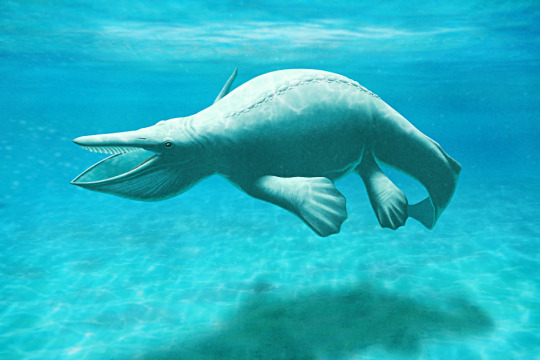
Hupehsuchians were small marine reptiles closely related to ichthyosaurs, known only from the Early Triassic of southwestern China about 249-247 million years ago. They had toothless snouts, streamlined bodies, paddle-like limbs, and long flattened tails, along with a unique pattern of armor along their backs made up of overlapping layers of bony osteoderms.
Hupehsuchus nanchangensis was a mid-sized member of the group, about 1m long (3'3"). Newly-discovered fossils of its skull show that its long flattened snout had a distinctive gap between the bones (similar to the platypus-like snout seen in its relative Eretmorhipis) with an overall shape surprisingly convergent with that of modern baleen whales – suggesting that this hupehsuchian may have been a similar sort of filter-feeder.
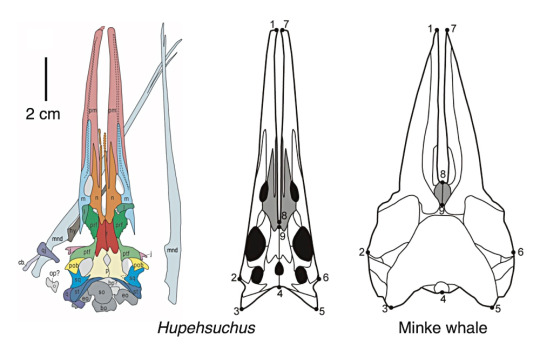
Hupehsuchus skull compared to a modern minke whale [From fig 2 & fig 3 of Fang et al (2023). First filter feeding in the Early Triassic: cranial morphological convergence between Hupehsuchus and baleen whales. BMC Ecol Evo 23, 36. https://doi.org/10.1186/s12862-023-02143-9]
Grooves in the bones along the outer edges of its upper jaws may be evidence of filtering structures similar to baleen, although with no soft-tissue preservation we don't know exactly what this would have looked like. Its slender flexible lower jaws probably also supported a large expandable throat pouch, allowing it to filter plankton out of larger volumes of water.
———
NixIllustration.com | Tumblr | Patreon
#science illustration#paleontology#paleoart#palaeoblr#hupehsuchus#hupehsuchia#ichthyosauromorpha#reptile#marine reptile#art#triassic weirdos
603 notes
·
View notes
Photo

Polished Fossil Slab – Fish, Shark, Reptile Bone & Coprolite, Aust Cliff UK, Triassic Period
Presenting a rare and scientifically significant Polished Slab of Fossil Fish, Shark Bone, Reptile Bone, and Coprolite from the Westbury Formation, part of the Penarth Group, dated to the Upper Triassic (Rhaetian) approximately 208–201 million years ago. This exceptional piece was sourced from Aust Cliff, near Bristol, United Kingdom, a world-famous Triassic fossil locality.
The slab contains a unique fossil assemblage including:
Fragmented fish bones and scales
Shark and marine reptile bone fragments
Abundant coprolites (fossilised faeces), often spiral or rounded in morphology
All fossil components are preserved within a dark, fine-grained sedimentary matrix and have been expertly polished on one surface to reveal the textures, inclusions, and contrast of this fossil bed.
Fossil Type: Multi-species fossil bed including vertebrate remains and trace fossils (coprolites)
Geological Age: Upper Triassic – Rhaetian Stage
Formation: Westbury Formation
Group: Penarth Group
Depositional Environment: Formed in a coastal lagoonal or shallow marine setting with fluctuating salinity and periodic anoxic events. The Westbury Formation is known for bone beds where marine vertebrates and organic debris accumulated and were rapidly buried in low-oxygen sediments, aiding exceptional preservation.
Morphological Features:
Irregular fragments of fish and reptile bone, embedded in matrix
Rounded and spiral coprolites of varying sizes
Polished surface highlights bone textures and organic inclusions
Notable:
Authentic slab from Aust Cliff, one of the most famous Upper Triassic sites in the UK
Displays diverse fossil content in a single polished surface
Excellent for collectors, museums, academic study, or decorative purposes
The actual specimen shown in the listing photograph
Authenticity: All of our fossils are 100% genuine natural specimens and come with a Certificate of Authenticity. The item photographed is the exact specimen you will receive. Each cube or square in the scale represents 1cm – please refer to the image for full sizing.
This Polished Fossil Slab from Aust Cliff offers a fascinating snapshot of life in the waning years of the Triassic period, preserved within the storied sediments of the Westbury Formation. A rare and beautiful piece for any serious collector or enthusiast.
#Aust Cliff Fossil#Westbury Formation#Coprolite Fossil#Reptile Bone Fossil#Fossil Fish Slab#Triassic Fossil UK#Fossil Shark Bone#Upper Triassic Fossils#Bristol Fossil Bed#Fossil Reptile Slab#Fossil Collector Specimen#Genuine Fossil Slab#UK Fossil#Penarth Group Fossil
0 notes